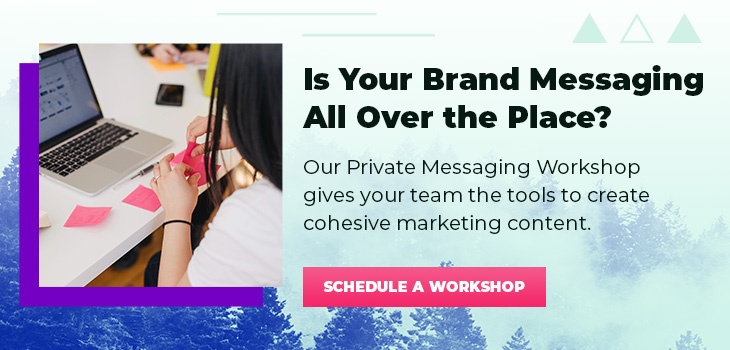An idea that was once just another marketing book has rapidly taken its rightful place as the frontrunner in the way twenty-first century brands relate to their customers.
That idea is the StoryBrand Framework, and what some might now refer to as an element of Business Made Simple University (BMSU). Originally created solely as a means of developing clear brand messaging, it has become so much more in the hands of forward-thinking marketers. At a birds-eye-view, it’s a marketing methodology, or ‘mindset,’ that puts your customer and their concerns at the center of your brand.
What makes the StoryBrand methodology so appealing is the simplistic and universally applicable nature. Sure, there are nuances to learn as with any revolutionary concept, and we will get to those. But ultimately, it’s one of the simplest models in the marketing, advertising and branding world that extends itself to infinite applications; some of those being customer-facing collateral and others serving as internal guides on how to build delightful customer experiences.
For those interested in learning more about the StoryBrand Framework and how to apply its actionable tools to their brand, we'll cover all that below. But before we get there, we're going to talk about how the StoryBrand philosophy found traction among the marketing elite — and more importantly — why.
👉 Get more out of StoryBrand with our eBook. Download it here.
The Stage for Building a StoryBrand
Traditionally, a lot of brands face the same problem in their marketing (and most don’t even realize it’s a problem). They focus all of their messaging on their brand; it’s all about them. “We refuse to compromise quality.” “We have the best prices in town.” “We started as a grassroots movement.” While that’s all well and good, people don’t care. It's the truth. Talking about yourself won’t grab someone’s attention, but as soon as you make the conversation about them they’re all ears.
Great brands know this. That’s why they focus on their customer’s needs instead of the brand’s accolades. All of their marketing messaging — whether it’s digital marketing, commercials, billboards or fliers — is focused on the client’s problem and how their product can help.
Enter — the StoryBrand Framework. StoryBrand was born from Donald Miller’s best-selling book, Building a StoryBrand, which evolved into mystorybrand.com and a StoryBrand podcast. His creative marketing framework quickly became a guide to business owners navigating the Hunger Games that is the free marketplace by moving people from problematic marketing to a customer-centered focus.
What makes StoryBrand so special is that it has taken the powerful philosophy of customer-centered marketing and created an applicable roadmap for brands to use that’s compelling and shockingly simple. Any brand that adopts it can use it within every level of their strategy, from determining their positioning and catalyzing product-market fit to brand messaging and product descriptions. It’s never been so easy to relate to your customers and bring them into your sales funnel. By shifting your focus, you’ll go from a standard brand tooting its own horn, to a story-driven brand that easily and organically connects with customers.
The Power of Story
The concepts presented in StoryBrand’s Framework aren’t new. They are based on the time-worn principles of storytelling.
Despite our unique quirks and individual personalities, human beings all process information basically the same way. In fact, humans are 22 times more likely to remember facts if they’ve been presented in a story. All StoryBrand marketing does is work with that process instead of against it to engage people with your brand messaging and clearly communicate key concepts.
The human brain is geared to remember stories better than straight-up facts. Let me ask you a question. How many soldiers died in the Vietnam War? You probably can’t call up a specific number off the top of your head. (Don’t worry neither could I.) How about this question: Did Lt. Dan die in the Vietnam War in Forrest Gump?
I know, I know, it seems like a strange comparison. But the point is, the war was depicted in the movie and you probably remember more of it from there than you do from your history textbook. Why? Because it was a story. There were characters you could identify with and a plot that engaged your curiosity and emotions. Each section of the film introduced a problem, and you kept watching and waiting to see it resolved and the story loop closed. This is why you remember so much from the movie. StoryBrand’s marketing framework boils that down into a simple formula so you can be just as memorable as Forrest Gump.
Donald Miller explains in his book that people are innately making decisions based on two basic needs: survive and thrive. To make a purchase, something either has to help us survive (food, water, shelter, etc.) or thrive in our environment (social standing, ease of use, saving time, etc.). And to make it even more difficult for marketers, we humans don’t want to spend a single extra calorie processing information to determine if it fits into either of these categories, so your message has to get straight to the point.
It might seem like it would take forever to implement all this psychology into your marketing materials, but it’s actually easier than you’d think and it can apply in almost any context.
Overview of the StoryBrand Framework
Moving right along, StoryBrand’s messaging framework makes it easy to engage potential customers. The main thing to keep in mind, which we’ve touched on a bit already, is that the customer is the hero of your story. Figuring out how to do this is usually where people feel lost, so let’s take a closer look at the 7-part StoryBrand Framework.
- Make your customer the hero. First and foremost, you have to place your customer at the center of your narrative. Forget citing the details of a new product or all the awards your brand won last year. Your marketing message should be about the customer’s story and your brand just happens to be there.
- Identify the problem your customer is facing. To make someone the center of your story, it has to be all about them. The easiest way to appeal to that “survive and thrive” mentality we all have is to address a legitimate problem someone is facing. If you sell running shoes, the "problem" could be poorly supportive shoes that cause injuries and shin splints.
- Introduce yourself as their guide. Now you’ve reminded the customer of a problem, but they have no idea how to fix it. *Cascade of fairy dust.* So you appear! The Yoda to their Luke Skywalker; the Dumbledore to their Harry Potter. You’re here to help them find a solution to their terrible shoes because you get it. Maybe your CEO was a triathlete or your team does an annual 5k. Whatever it is, you understand bad shoes equals bad moods, and you’re here to help.
- Plan the steps to success. Unfortunately in life, we can't simply pass Go and collect $200. Steps must be taken before we find a solution, so your brand will help to lay out a plan to get there. It could be as easy as consulting your sizing chart to find the right size or downloading your specs sheet to determine the perfect shoe for their needs.
- Extend a call to action. You can lead a horse to water...right? But maybe that horse never drank because no one ever asked it to. Neither will your customers make a purchase if you don’t ask them to. A call to action is an important part of the framework because it tells your customers exactly what they need to do with you to solve their problem. You can even include transitional calls to action for customers who need to get their feet wet before diving right in.
- Show them failure. Even after all this leg work, people might still be wondering “Why is this brand any better?” So this section of the framework addresses exactly that. You can show them how using other shoe brands won’t cushion their heels or support their high arches the way yours does, and so they might spend $100 or more just to have the same problem as before.
- End with a win. And of course, you want to leave them feeling confident. Show them what success looks like with you. Shoes with support developed by scientists that relieve shin splints and arch pain so they can run faster, longer.
How StoryBrand Can Help Brands Big and Small
At this point, you might be thinking one of two things:
- My business is way too small to fit all that into my messaging.
- My company already has its brand figured out. I don’t want to overhaul what’s working just to include StoryBrand.
Both of these concerns are valid. However, if you’re intrigued enough by StoryBrand to try it out anyway, you might be pleasantly surprised. It’s incredibly easy to scale down the framework to even a single product, so you don’t have to overhaul your entire marketing program just to see if it would work for you.
📺 Check out this interview with our CEO about how Enterprise organizations can use StoryBrand. 👇
StoryBrand for Your Website
Some businesses will opt to include StoryBrand when they’re redesigning or building a new website. This is the perfect time to retool your brand message and some websites have really knocked it out of the park.
Indulge Right is one of these websites that we absolutely love. They specialize in healthy sweets and their main header tells people to “Indulge without compromise.” The line is surrounded by a header dripping with caramel and a scrumptious image of caramel being drizzled on cheesecake. Go ahead, try not to want a bite. I dare you.
Their website also follows the five must-haves of StoryBrand website design:
- A simple navigation bar with no more than five options.
- Most important content is above the fold so readers immediately know what the brand is about.
- The layout represents your services and the process customers must go through to access them.
- A clear call-to-action is prominently displayed.
- They share testimonials from happy customers.
No matter the size or scope of your brand, implementing StoryBrand is as easy as 1, 2, 3 … 4, 5.
StoryBrand in Your Marketing and Product Messaging
If you’re still not ready to go all in on StoryBrand, that’s okay! We won’t push you into the deep end. We can wade around with you on the shallow side too because this particular marketing strategy can work in any area of the pool. And for a flotation device, you’ll have your StoryBrand BrandScript.
As I mentioned earlier, StoryBrand can get as granular as you need it to, all the way down to a single product campaign. This is because the BrandScript provides a sort of template for you to boil down your communication into one focused, clear message. It helps you identify your product, what makes it unique, what problems it solves for customers and even the steps they need to take to purchase it.
👉 Check out How the StoryBrand BrandScript Can Help Any Product Sell Itself
StoryBrand in Sales
This framework helps your sales team by providing a cohesive outline of who your customer is, exactly how you solve their problem and what success looks like. It helps to get everyone on the same page with what your messaging is and where the focus lies. This way, you have a clear and consistent marketing message across the board about your company and the value you bring to the table.
In addition to unifying your brand voice, the StoryBrand Framework can help your sales team quickly understand the customer's problems and how to speak to them. Knowing exactly what issues they’re speaking to can help your salespeople be more effective in their efforts because they can directly address what customers want. No more energy wasted trying to sell aspects of products that don’t matter to the customer.
StoryBrand in Customer Service
Thus far we’ve discussed the applications of the StoryBrand framework in attracting and closing more customers. But the framework is also helpful when engaging with your current customers. If your whole customer service team is on the same page, your team will be aligned with the value you offer and the services you provide. So when the customer sees your message and expects a specific experience, that’s exactly what they get.
When your customer service team knows exactly what problems your customers are trying to overcome, they can be more empathetic and quicker to find a solution. This can be instrumental when dealing with difficult customers or complex issues, which are bound to come up. Customer service representatives can always fall back on the pieces of the plan you’ve laid out for them so they have a guiding light for handling “gray areas” with customers.
Implementing StoryBrand for Your Brand
There are two ways a brand can effectively adopt and implement the StoryBrand Framework, both being necessary to see optimal return. The first is strategic; think of this as a philosophy and approach that you weave into every conversation, decision, and move you make within your business. The second is technical; the applicable changes you make to your brand message and communication language that puts your customers at the center of the story.
As a StoryBrand Certified Agency, we can guide you through both. Your entire staff can go through a Private StoryBrand Workshop to get fully aligned and functioning with the same exact mindset, removing years of confusion about who you are and what you do. As for messaging, our writers have developed 100+ brand messaging guides and BrandScripts to be used for brand communication in any channel or context.
When you put yourself in your customer’s shoes, it creates a whole new outlook on how you position your brand. Suddenly, you’re identifying with the key problems you confront and learning more about your own business along the way. Tapping into the StoryBrand Framework will help you focus your message on the right audience and communicate it in a way that grabs their attention. No more wasted time brainstorming how to attract new business. You’ll tap right into people’s natural instincts and create a loyal customer base.









